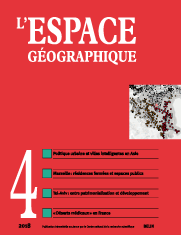

The adoption of smart grid technology by Japanese developers: A real estate perspective on the smart city (1 encadré; 1 fig.; 7 tabl.)
Despite the influence of real estate companies on the production of the built environment, their role of in smart city initiatives has been overlooked. As part of a smart city demonstrator program implemented by the national government, Japan has witnessed the large-scale adoption of smart grid technology by condominium developers. The article shows how the practical implementation of this government initiative was determined by the strategic motivations of the developers, the latter having equipped their mid-range condominiums with smart grids in order to attract buyers with “club” services. The analysis is based on a corpus of 137 condominiums equipped with this technology and a case study analysis of a residential complex.
keywords: CONDOMINIUM, JAPAN, REAL ESTATE, SMART CITY, SMART GRID
Smart cities in Vietnam: Between national implementation and metropolitain strenghtening of Hanoi (5 fig.)
Vietnam has been promoting smart cities since 2015. We conjecturally consider the opportunities, challenges and implications of these recent urban policies. The article argues that, at the national level, the appropriation of the smart city model induces an increase of foreign private capital in urban production but also constitutes an opening for rebalancing development towards medium-sized territories. At the scale of Hanoi, the introduction of the smart city discourse seems to appear as the last inflection given to the implementation of the Master Plan 2030-2050 which aims to make the capital a competitive metropolis in Asia.
keywords: INVESTMENT, MOBILITY, PUBLIC POLICY, SMART CITY, SPATIAL PLANNING, VIETNAM
Gated communities in Marseille, urban fragmentation becoming the norm? (11 fig.; 2 photos)
In recent decades, gated communities have multiplied in Marseille, the third French metropolis. The dynamics of enclosure have taken the form of secure new-built residential projects or closure of existing streets. These dynamics are facilitated by specific legacies of privatized urbanism and informal arrangements for local management. As part of a postindustrial urban renewal strategy, the city has undertaken neoliberal options. The working-class city center continues to deteriorate while the centrifugal tendencies initiated by developers or co-owners are reinforced. Unregulated, fences transform the local urban model, privatize environmental amenities, restrict access to public facilities, and limit pedestrian mobility. This paper is based on 10 years of research and field surveys that have helped to establish a statistical, geomatics and qualitative database of more than 1,500 residences.
keywords: ACCESSIBILITY, GATED COMMUNITIES, MARSEILLE, NEOLIBERAL CITY, REAL ESTATE, URBAN FRAGMENTATION
Tel-Aviv White City: The construction of urban heritage and its effects on the development of the city
In 2003, Tel-Aviv was listed as a UNESCO World Heritage Site for its modern architecture and urban planning. This date has been decisive for the history of the city and for its storytelling, as for the relatively free transformations of buildings identified with Bauhaus style and the practice of building above heritage houses. From then on these modifications are prohibited by the rules of town planning, while at the same time, newer buildings are raised by several floors and many new towers are built. The Tel-Aviv study allows, from this point of view, to answer a general question about heritage classification and the paradoxical effects of urban heritage in a fabric that is becoming denser and transforming very quickly, while precautionary measures are taken against this.
keywords: ARCHITECTURE, HERITAGE, URBANISM
“Medical deserts” in France: Current state of research and future directions (4 fig.; 2 tabl.)
The concept of “medical desert” is largely used in France to describe areas where inhabitants lack proper access to health care. However, the fuzziness of the concept does not allow for an adequate description of the multiple issues involved neither does it help to consider appropriate remediation measures. The aim of this paper is first to analyse the evolution of a low level accessibility index to general practitioners (GPs) over time. We then analyse how public authorities have addressed the issue of “medical deserts” by focussing on two measures: the definition of priority zones and the implementation of incentives to attract and retain GPs in these areas. Thus, we identify avenues for further research to improve the description of GPs accessibility and the evaluation of public policy measures aiming at reducing “medical deserts”.
keywords: ACCESSIBILITY, CARE, GENERAL PRACTIONNER, MEDICAL DESERT, SPATIAL PLANNING
L’espace géographique 3/18![]()
![]() L’espace géographique 1/19
L’espace géographique 1/19
For subscribe or buy this issue: BELIN
![]() L’Espace géographique: contents
L’Espace géographique: contents
Last modified: December 14, 2018